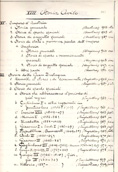Electronic retrospective conversion
of the Sacconi Catalogue
(Italiano / English)
The Sacconi catalogue was compiled in the second half of XIX century by
Torello Sacconi, librarian and, for some years, Interim Director of the
National Central Library of Florence. It is structured in 21 topics, according
to a tipically XIX century classification scheme. It consists of more
than 200,000 catalogue cards, the majority of which is handwritten. The
catalogue is accessed by the means of a systematic Index, with ca 6,000
subdivisions. Each of them has a number, which allows to identify the
related card.
In 1892, Sacconi
gave the Catalogue to the Marucelliana Library, where it was continued
for several years before it came back to the National Central Library.
For many years it has been neglected and excluded from public use. Fortunately,
there are only a few cards missing and the catalogue has kept its original
structure.
Recently the National
Central Library of Florence realised a conversion of the Sacconi catalogue
using an image scanning technique. The aim was to preserve and to add
more value to one of the historical catalogue of the Library. In this
way a less known but useful bibliographical tool is provided.
The major feature
of this catalogue, which also motivated its electronic retroconversion,
is the richness of the contained information. Many bibliographical records
are available, which are structured by subject and are related to the
period XVI-XIX century. The importance of the catalogue lays in the fact
that the National Central Library of Florence has no subject catalogue
available for its antiquarian collections (the subject catalogue started
only in 1926).
In retrieving the
digitalised image, the project has respected the structure of the old
catalogue. It is conform to the same arrangement of the original cards.
The revision work has been limited to slight checks intending to give
internal coherence to the catalogue. The only major intervention has been
to arrange the cards in alphabetical order within the single subdivisions.
All cards have been
scanned through optical techniques, whereas the systematic Index has been
keyboarded as a text in electronic form and it is now the basis for consultation
and navigation within the catalogue. The hierarchical structure, created
by Sacconi, has been transformed in the electronic organisation of the
text, with the possibility of expanding and collapsing it, or to check
it with ad hoc queries. The maximal expansion is the display of the complete
Index. Key words queries are possible with direct link to the card display
in sequential order. A "help" tool is always available.
